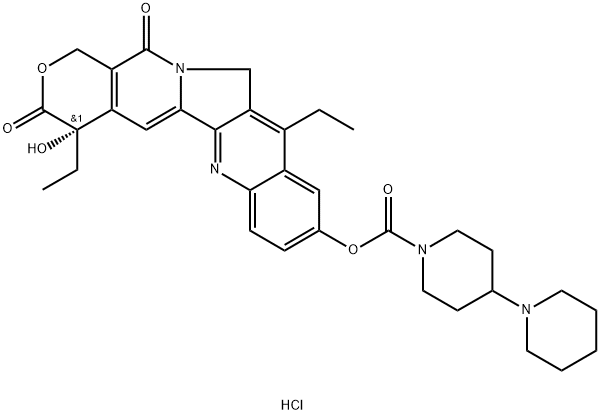Irinotecan hydrochloride C화학적 특성, 용도, 생산
개요
lrinotecan hydrochloride, a semi-synthetic, water soluble derivative of the potent
anticancer agent camptothecin, was launched in Japan for the treatment of lung,
ovarian, and cervical cancers. lrinotecan exerts its antitumor activity via inhibition
of topoisomerase I, a cellular enzyme that is involved in maintaining the topographic
structure of DNA during the process of translation, transcription, and mitosis.
lrinotecan undergoes de-esterification in vivo to yield an active metabolite, SN-38,
which is 1000-fold more potent than the parent. Although being much less toxic than
camptothecin, a significant number of patients in clinical trials exhibited side effects
of leukopenia, diarrhea, nauseahromiting, and alopecia. Combination therapy of
irinotecan with another widely used anticancer agent, cisplatin, has been reported to
be superior to either agent alone. lrinotecan is in clinical trials for gastrointestinal,
breast, skin, colorectal, pancreatic cancers, mesothelioma and non-Hodgkin's
lymphoma.
화학적 성질
Yellow Crystalline Powder
용도
Irinotecan hydrochloride has been used:
- in combination with 5-fluorouracil for screening growth inhibitory functionality in MDA-MB-231 breast cancer cells.
- in chemosensitivity screening of high-grade appendiceal (HGA) and low-grade appendiceal (LGA) organoids.
- as a chemotherapeutic agent in the cytotoxicity studies in combination with heat shock proteins inhibitors (HPSC1) in HT29 colon cancer cells.
정의
ChEBI: A hydrochloride obtained by combining irinotecan with one molar equivalent of hydrochloric acid. Used (in the form of its trihydrate) in combination with fluorouracil and leucovorin, for the treatment of patients with metastatic adenocarcinoma of the pancr
as after disease progression following gemcitabine-based therapy. It is converted via hydrolysis of the carbamate linkage to its active metabolite, SN-38, which is ~1000 times more active.
일반 설명
Irinotecan is available in 100-mg or 5-mL vials for IV administrationand is used in combination with 5-FU and leucovorinas first-line treatment of metastatic colon cancer.The agent may also be used as a single agent in colorectalcancer as a second-line therapy when 5-FU therapy hasfailed. Additional uses include small cell lung cancer,NSCLC, cervical cancer, esophageal cancer, and gastric cancer Irinotecan is 30% to 60% plasma protein bound, whereasthe active metabolite SN-38 is 95% protein bound. Bindingof SN-38 as the lactone stabilizes the material to ring opening.The elimination of the agent occurs primarily in the bilewith a minor amount of renal elimination. The excretion ofactive metabolites or inactive metabolites such as the glucuronideSN-38G, which may be converted back to SN-38 inthe bile, has been associated with severe diarrhea. Irinotecanand SN-38 have half-lives of 8 and 14 hours, respectively.Irinotecan has two dose-limiting toxicities, myelosuppressionand diarrhea. The diarrhea occurs in two forms, earlyand late. The early form occurs within the first 24 hours afteradministration. It has been associated with inhibition ofacetylcholinesterase, which results in increased gut motility.This early phase is also associated with flushing, abdominalpain, and excessive sweating. Atropine can be used to relievethese symptoms but it is not recommended for prophylacticuse unless there has been a prior episode. The late-phasediarrhea occurs after 24 hours and has been associated withthe presence of active material, particularly SN-38 in the gut,and may last 3 to 10 days. The prolonged nature may lead todehydration and electrolyte imbalances. Loperamide therapyis recommended at the first appearance of a loose stool. If thediarrhea persists, additional agents may be used includingantibiotics that decrease β-glucosidase–producing bacteria inthe gut and prevent the overgrowth of pathogenic bacteria.111Other toxicities include emesis and alopecia.
생물학적 활성
Inhibitor of DNA topoisomerase I that displays antitumor activity against a range of tumor types.
Clinical Use
In combination with fluorouracil, this prodrug camptothecin analogue is considered to be first-line therapy in the treatment of metastatic colorectal cancer. It also has shown efficacy in small cell and nonsmall cell lung cancers when used in combination with cisplatin.
부작용
Delayed diarrhea induced by irinotecan is dose-limiting and potentially fatal, and vigorous loperamide therapy should be instituted at the first sign of symptoms. Acute diarrhea is attributed to the drug's ability to inhibit acetylcholinesterase and can be addressed through anticholinergic pretreatment. Pretreatment also helps patients to avoid “cholinergic syndrome,” a collection of annoying side effects that include flushing, sweating, blurred vision, lacrimation, and less commonly, bradycardia. Camptothecins also are myelosuppressive, and neutropenia can be severe, particularly in patients with elevated bilirubin levels. Extensive biotransformation also demands cautious use of irinotecan in patients with hepatic dysfunction.
신진 대사
The drug is slowly bioactivated in the liver through hydrolysis of the C10-carbamate ester. The catalyzing enzyme is a saturable carboxylesterase known as irinotecan-converting enzyme. Levels of active metabolite, known as SN-38, are 50- to 100-fold lower than the parent drug, but preferential protein binding of the lactone (95%) permits significant plasma levels of the optimally active SN-38 compared to the hydroxy acid metabolite. SN-38 has a terminal half-life of 11.5 hours (compared to 5.0–9.6 hours for the prodrug parent) and is glucuronidated at the C10 phenol before elimination. CYP3A4 also cleaves the terminal piperidine ring through oxidation at the α-carbons, followed by hydrolysis of the resultant amides, producing inactive metabolites. Excretion of the parent drug and metabolites is renal (14–37%) and, to a lesser extent, biliary.
Irinotecan hydrochloride 준비 용품 및 원자재
원자재
준비 용품







